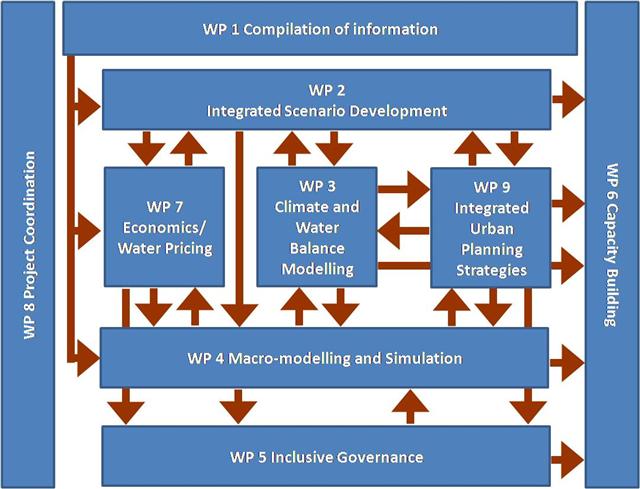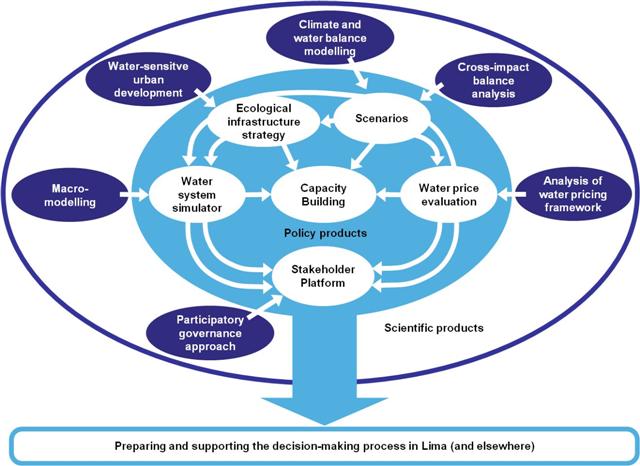
The LiWa project particularly focuses on the development and application of fundamental procedures and tools for participatory decision making, based on informed discussions. The project builds upon modelling and simulation of the entire water supply and sanitation system within the urban growth centre system of Lima. Furthermore, the project develops and evaluates options for redesigning the water tariff system to meet economic, ecologic and social requirements. With this approach, key issues and challenges of energy and climate-efficient structures of water and wastewater management will be adequately addressed.
Due to its importance, not only to Lima, but also globally, the lifeline water is chosen as the focal topic of the LiWa project. Using the example of Lima (a case with particular challenges), methods and tools will be developed to analyse a life-line system. Based on this analysis, strategies and governance proposals will be generated that promise to combat effects of climate change in a sustainable way.
The following main tasks and specific project objectives have been identified for the LiWa project (besides project management and dissemination):
1. Integrated scenario development
Due to the uncertainty of the climate change impacts and the variability in selecting and implementing mitigation and adaptation measures, it is mandatory to work with a set of scenarios that reflect a breadth of developmental options and provide orientation for the decision makers. (cf. Fig. 1, Workpackage 2)
2. Climate downscaling, water balance, water supply and hydropower modelling
The main objectives here are: Downscaling of climate change scenarios to the local scale and the simulation of the regional river basin catchments in the climate scenarios to include the effects of climate change on the water resources available for water supply, eco-systems and hydropower generation. (cf. Fig. 1, Workpackage 3)
3. Macro-modelling and simulation system
The main objective here is to develop a simulator for the visualisation, modelling and simulation of the entire water system and other resource fluxes within the urban growth centre of Lima. This simulator will be applied for the evaluation of scenarios and operational variants and will help in long-term planning, taking into account climate change impacts and incorporating different sets of values and preferences. (cf. Fig. 1, Workpackage 4)
4. Participation and governance approach
The main objective here is to develop and test suitable processes for stakeholder and public involvement that link the outcomes of the integrated models (analytic component) with deliberative methods of decision making and public involvement. Other objectives include: Exemplary implementation for resolving specifically salient conflicts and development of an Integrated Governance Framework that includes government officials, economic players, representatives of sciences and civil society. Only if these forces interact and cooperate is positive change likely to occur. (cf. Fig. 1, Workpackage 5)
5. Education and capacity building
The main objective here is to assist managers in capacity building and capability empowerment with respect to further mitigation and adaptation measures including cooperative structures between public authorities, Lima's water company, stakeholders and future professionals. The underlying goal is to implement institutional structures that assure effective, efficient, financially viable and socially acceptable ways to manage water resources. (cf. Fig. 1, Workpackage 6)
6. Economic evaluation of water pricing options
The main objectives here are to identify and evaluate water pricing options that promise to overcome water quality and quantity problems in Lima. It will be analysed how well different options are able to recover the costs of water supply, meet distributional goals and overcome institutional and political-economical obstacles. Moreover, light will be shed on possible changes of the institutional framework, which may be necessary to implement a pricing reform. (cf. Fig. 1, Workpackage 7)
7. Integrated urban planning strategies and planning tools
Development of water-sensitive, multifunctional urban planning strategies and tools. (cf. Fig. 1, Workpackage 9)

Figure 1: Workpackages of the LiWa project
The project comprises of (altogether) ten partners, including research and education institutions, the major water utility, NGO partners and SME representatives. The partners complement each other in their expertise in the various aspects of sustainability related to critical infrastructure systems. The project itself focuses on six core aspects, as illustrated in Figure 2.

Figure 2: Overview of the LiWa project methodology and of its products
The LiWa project is designed as a seed project, i.e. during course of the project the essential core elements are expected to be extended by additional activities (also by third parties, including industry) outside the project (using third-party funding), but in close collaboration with the LiWa project. Such an approach appears to be prudent due to the dynamic nature of the task and the inherent uncertainty involved in climate change issues.
A second feature of the projects underlying philosophy is a two-tier approach: Decision makers and the population are requesting quick measures to be taken, but, at the same time, also the necessity to provide solutions and approaches which are sustainable seen from a long-term perspective. Therefore, a bridge has to be built (and the potential risk is minimised) between the need for successes on a short-term basis (e.g. for attaining public support by politics and by the population of Peru) and the need for truly sustainable long-term concepts.
Experiences of the preliminary project phase also confirm the need for neutral yet inclusive advice for strategic decisions to be made for sustainable planning and operation of the water lifeline system. Therefore, the third feature of the project is its reliance on analytical and deliberative processes. The integration of analysis and deliberations ensures that the best scientific knowledge is the guiding principle for designing policies and, at the same time, that technically and economically feasible options are generated and evaluated in a participatory process. The policy products need to be effective, ecologically sound, economically efficient and socially acceptable. In short the policies need to be sustainable. This purpose is also served by the strong emphasis on education and training which assures the continuity of the projects objectives even after the project is completed.
The LiWa project is designed to organize an effective and efficient
transfer of information between the relevant actors in the area of
interests, such as scientists, engineers, water and sanitary experts,
decision makers and representatives of the civil society. At the same
time, sustaining a continuous flow of information and communication
throughout the entire research process constitutes the major innovative
aspect of this project, since most communication programs in this field
place communication at the end of the process. The emphasis in these
conventional programs is on disseminating the result to a wider audience,
while this project emphasizes constant feedback and learning among the
participants and between the participants and potential users and policy
makers. The LiWa project will therefore include a large variety of
social actors (government, administration, civil society, private sector
and education system) during all crucial stages of the project.